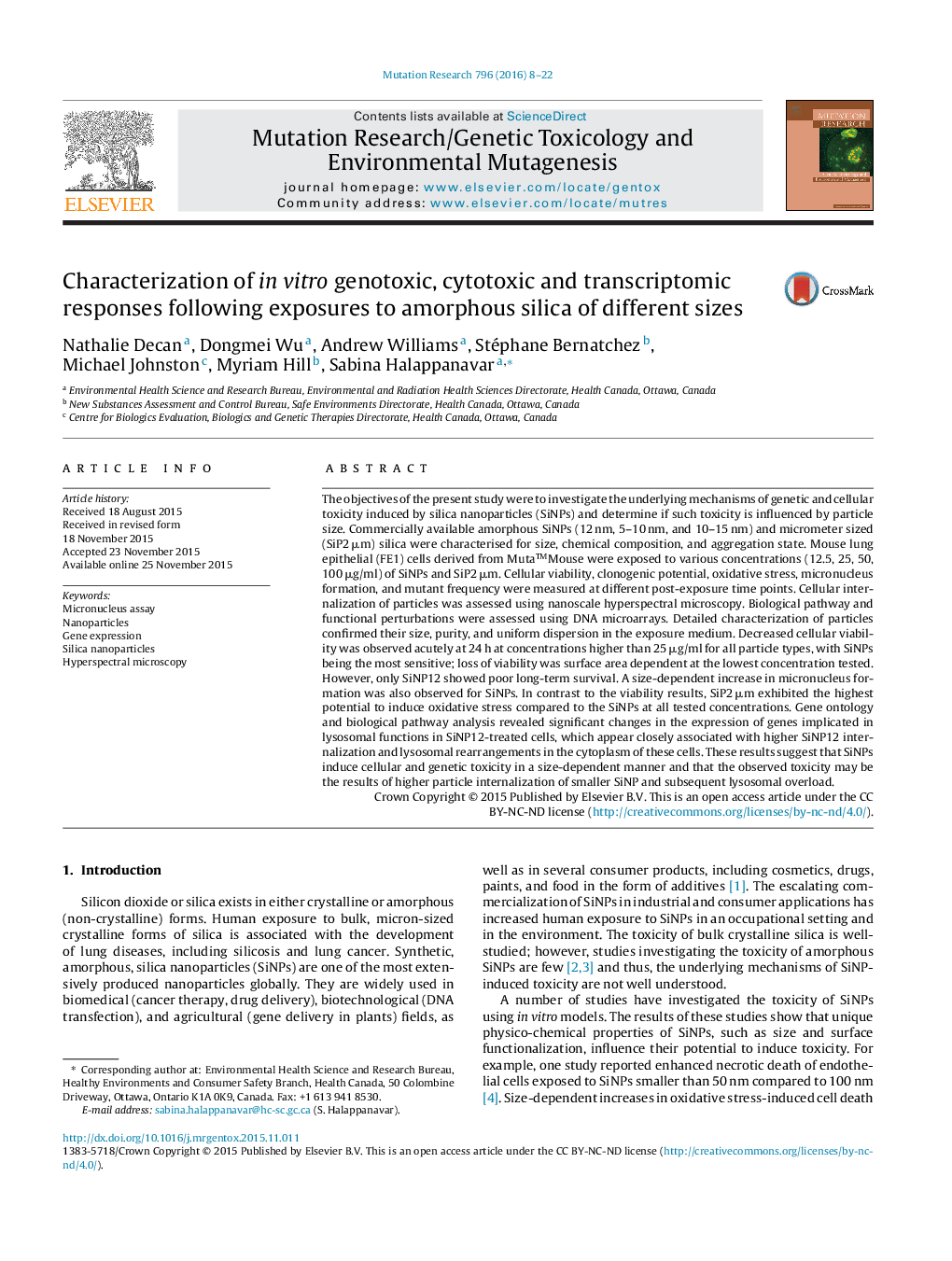| کد مقاله | کد نشریه | سال انتشار | مقاله انگلیسی | نسخه تمام متن |
|---|---|---|---|---|
| 8456284 | 1548571 | 2016 | 15 صفحه PDF | دانلود رایگان |
عنوان انگلیسی مقاله ISI
Characterization of in vitro genotoxic, cytotoxic and transcriptomic responses following exposures to amorphous silica of different sizes
دانلود مقاله + سفارش ترجمه
دانلود مقاله ISI انگلیسی
رایگان برای ایرانیان
کلمات کلیدی
موضوعات مرتبط
علوم زیستی و بیوفناوری
بیوشیمی، ژنتیک و زیست شناسی مولکولی
تحقیقات سرطان
پیش نمایش صفحه اول مقاله

چکیده انگلیسی
The objectives of the present study were to investigate the underlying mechanisms of genetic and cellular toxicity induced by silica nanoparticles (SiNPs) and determine if such toxicity is influenced by particle size. Commercially available amorphous SiNPs (12 nm, 5-10 nm, and 10-15 nm) and micrometer sized (SiP2 μm) silica were characterised for size, chemical composition, and aggregation state. Mouse lung epithelial (FE1) cells derived from Mutaâ¢Mouse were exposed to various concentrations (12.5, 25, 50, 100 μg/ml) of SiNPs and SiP2 μm. Cellular viability, clonogenic potential, oxidative stress, micronucleus formation, and mutant frequency were measured at different post-exposure time points. Cellular internalization of particles was assessed using nanoscale hyperspectral microscopy. Biological pathway and functional perturbations were assessed using DNA microarrays. Detailed characterization of particles confirmed their size, purity, and uniform dispersion in the exposure medium. Decreased cellular viability was observed acutely at 24 h at concentrations higher than 25 μg/ml for all particle types, with SiNPs being the most sensitive; loss of viability was surface area dependent at the lowest concentration tested. However, only SiNP12 showed poor long-term survival. A size-dependent increase in micronucleus formation was also observed for SiNPs. In contrast to the viability results, SiP2 μm exhibited the highest potential to induce oxidative stress compared to the SiNPs at all tested concentrations. Gene ontology and biological pathway analysis revealed significant changes in the expression of genes implicated in lysosomal functions in SiNP12-treated cells, which appear closely associated with higher SiNP12 internalization and lysosomal rearrangements in the cytoplasm of these cells. These results suggest that SiNPs induce cellular and genetic toxicity in a size-dependent manner and that the observed toxicity may be the results of higher particle internalization of smaller SiNP and subsequent lysosomal overload.
ناشر
Database: Elsevier - ScienceDirect (ساینس دایرکت)
Journal: Mutation Research/Genetic Toxicology and Environmental Mutagenesis - Volume 796, 15 January 2016, Pages 8-22
Journal: Mutation Research/Genetic Toxicology and Environmental Mutagenesis - Volume 796, 15 January 2016, Pages 8-22
نویسندگان
Nathalie Decan, Dongmei Wu, Andrew Williams, Stéphane Bernatchez, Michael Johnston, Myriam Hill, Sabina Halappanavar,